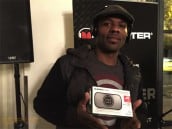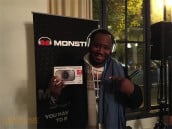Find Our Latest Video Reviews on YouTube!
If you want to stay on top of all of our video reviews of the latest tech, be sure to check out and subscribe to the Gear Live YouTube channel, hosted by Andru Edwards! It’s free!
Latest Gear Live Videos
New Tsunami Warning System Analyzes Hard Drives

Posted by Sheila Franklin Categories: Smartphones, Internet, Science,
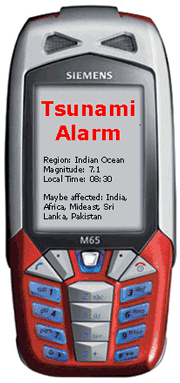 Ever since the 2004 tsunami, scientists have been searching for a better method to detect and warn us of upcoming earthquake-generated tidal waves. Austrian Michael Stadler may have devised an answer. Stadler has developed a program that accesses and analyzes data that comes from hard drive vibration sensors. Once the data is analyzed, it can be shared with other computers.
Ever since the 2004 tsunami, scientists have been searching for a better method to detect and warn us of upcoming earthquake-generated tidal waves. Austrian Michael Stadler may have devised an answer. Stadler has developed a program that accesses and analyzes data that comes from hard drive vibration sensors. Once the data is analyzed, it can be shared with other computers.
The program can ignore minor vibrations and differentiate between normal seismic and tsunamic activity. When “the big one” is about to occur, the system sends warnings to the other connected computers. Unfortunately, there is so much interest in the freeware download that his site seems to have crashed (no pun intended). Hang onto the link and try again in a day or two, or visit his suggested site of Dr. Eduard Heindl. Dr. Heindl has also created a warning system that can alert you by cell phone through a GSM network in any country at a price of EUR 9.95 (~$12.60) for a 1 month trial or EUR 29.95 (~$38.00) per year subscription.
Read More  | Michael Stadler Website
| Michael Stadler Website
Gallery: New Tsunami Warning System Analyzes Hard Drives
Advertisement
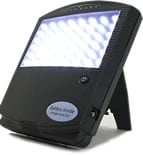 If you live in an area with long winters and tend to hibernate, or if you spend most of your time in the basement with your ‘puter, you might suffer from SAD (Seasonal Affective Disorder). Symptoms include depression, low energy, irritabilty, carb cravings (!), low concentration ability, insomnia, even social withdrawal and reduced libido.
If you live in an area with long winters and tend to hibernate, or if you spend most of your time in the basement with your ‘puter, you might suffer from SAD (Seasonal Affective Disorder). Symptoms include depression, low energy, irritabilty, carb cravings (!), low concentration ability, insomnia, even social withdrawal and reduced libido.
The Litebook may be the answer to your problem. It uses bright light therapy which involves regular (usually daily) exposure to an artificial light source at an accepted therapeutic intensity (> 2,500 lux). Exposure duration and distance from the source are set within certain limits.
Specifications:
- Size: 6” x 5” x 1” (15cm x 12.5cm x 2.5cm)
- Weight: 8oz. (225g)
- Impact-resistant ABS plastic injection-molded case
- Operates on AC (110-240v) and DC power with optional Adapter
- Low power consumption
- No UV Radiation
- UL certified
- Power adapter cord length 6’ (180cm)
The Litebook will become available this October at a MSRP of £199.00 (~$375.00). A battery recharger is also available for £235.00 (~$442.00). Occasional mild side-effects may occur, including headaches, a ‘stinging’ sensation in the eyes, and nausea, but we think that beats a 20-bags-of-Cheetos-a-day habit.
Read More  | Litebook Product Page
| Litebook Product Page
Gallery: Litebook May Relieve SAD
HydraCoach Interactive Water Bottle

Posted by Sheila Franklin Categories: Smart Home, Misc. Tech, Science,
 “The HydraCoach Thinks While You Drink.” Such is the claim of Sportline, the makers of the HydraCoach “interactive” water bottle. It tracks your fluid consumption and calculates your “personal hydration needs.” We didn’t even know we possessed such needs. We just assume that when we get thirsty, we drink water.
“The HydraCoach Thinks While You Drink.” Such is the claim of Sportline, the makers of the HydraCoach “interactive” water bottle. It tracks your fluid consumption and calculates your “personal hydration needs.” We didn’t even know we possessed such needs. We just assume that when we get thirsty, we drink water.
Other Product Capabilities:
- Paces an individual to ensure hydration goals are met.
- Monitors and motivates an individual to stay properly hydrated.
“With the launch of the world’s first ‘intelligent’ water bottle, we intend to revolutionize the water bottle and hydration industry,” said Brian Anderson, president of Sportline. “The benefits of proper hydration are sought after by athletes, fitness and outdoor enthusiasts, people trying to lose weight, the elderly, individuals on medication, and everyone who is generally health conscious.”
The HydraCoach goes on sale in December with a MSRP of $29.99. That’s big bucks for a bottle of water. We are thinking of substituting tequila to see how it calculates those personal hydration needs.
Read More  | Hydracoach Product Page
| Hydracoach Product Page
Gallery: HydraCoach Interactive Water Bottle
Winebot, Pass The Wine and Cheese

Posted by Sheila Franklin Categories: Smart Home, Misc. Tech, Science, Toys,
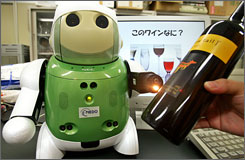 NEC and Mie University have teamed up in Japan to create the 2-foot Winebot, a cute little bugger that can not only discern good wine from bad, it can also name the brand and suggest a cheese.
NEC and Mie University have teamed up in Japan to create the 2-foot Winebot, a cute little bugger that can not only discern good wine from bad, it can also name the brand and suggest a cheese.
“There are all kinds of robots out there doing many different things,” said Hideo Shimazu, director of the NEC System Technology Research Laboratory and a joint-leader of the robot project. “But we decided to focus on wine because that seemed like a real challenge.”
Speaking in an underage voice, the robot names the brand and adds a comment to its taste. It can also be programmed to recognize wine that its owner prefers. Because of its ability to analyze the chemical composition of wine or food placed next to it, it could caution its owner about such health-related factors as fat or salt content.
Winebot doesn’t come cheap. “Buying one of these would cost about as much as a new car,” Shimazu said. “We’d like to bring that down to 100,000 yen ($1,000) or less for the tasting sensor if we were to put it on the market.”
We figure that if you can afford the wine and cheese, you can afford the Winebot.
Read More  | USA Today
| USA Today
Gallery: Winebot, Pass The Wine and Cheese
Bleeding Edge Byte 027: The Time Fountain, Behind The Scenes

Posted by Andru Edwards Categories: Features, Mods / Hacks, Science, Videocasts,
Unless you dropped off the face of the earth a few weeks ago, you probably ran across our own Nate True’s Time Fountain. In case you missed it, do a quick search and you will find it all over the Internet. We decided to take a closer look at what makes the Time Fountain tick. If you were amazed by the original video, consider this your “behind the scenes” look, explaining how the DIY project works.
Here’s how to get the show:
Subscribe: iTunes iPod / H.264 | iTunes MPEG-4 | RSS iPod Feed | RSS MPEG-4 Feed
|Download| - iPod-formatted H.264 (Mirror)
|Download| - DivX (Mirror)
|Download| - MPEG-4 (Mirror)
|Download| - PSP (Mirror)
 IMPORTANT: We are surveying the viewers of our show to see what it is that people like, and more importantly, what they don’t like. It is anonymous, and just takes a couple of minutes. If you have the time, we would appreciate it! As always, feel free to let us know what you think in the comments.
IMPORTANT: We are surveying the viewers of our show to see what it is that people like, and more importantly, what they don’t like. It is anonymous, and just takes a couple of minutes. If you have the time, we would appreciate it! As always, feel free to let us know what you think in the comments.
|Download| - iPod-formatted H.264
|Download| - MPEG-4
Gallery: Bleeding Edge Byte 027: The Time Fountain, Behind The Scenes
BOSS: Robot Shopping Cart That Returns Itself
Posted by Brian Viele Categories: Design, Mods / Hacks, Science, Transportation,
 Cart filled parking lots may soon be a sight of the past. A new smart cart created by a college student with all sorts of gadgets called “B.O.S.S” - which stands for “Battery Operated Smart Servant” - actually follows the shopper around the store, avoids obstacles, and most importantly, it can be made to return itself! While that sounds cool and all, we will certainly miss the days of the teenage part-timer running around parking lots to collect stray carts in the rain.
Cart filled parking lots may soon be a sight of the past. A new smart cart created by a college student with all sorts of gadgets called “B.O.S.S” - which stands for “Battery Operated Smart Servant” - actually follows the shopper around the store, avoids obstacles, and most importantly, it can be made to return itself! While that sounds cool and all, we will certainly miss the days of the teenage part-timer running around parking lots to collect stray carts in the rain.
Read More  | CNN
| CNN
Gallery: BOSS: Robot Shopping Cart That Returns Itself

Remember SETI (Search for Extra Terrestrial Life) from college? Students on college campuses, and people from home, all across the country interconnected through the World Wide Web searched for alien life through the magic of distributed computing. Well, Folding@Home (FAH) is another distributed computing application, but for molecular simulation - specifically, protein folding - and it will be available for the Playstation 3. Using the potential of the Cell processor will allow for capabilities only possible before from supercomputers. Additionally, technologies in the new RSX graphics processor in the PS3 allow for real time graphical representation of the folding process.
Read More  | Folding@Home at Stanford
| Folding@Home at Stanford
Gallery: Folding@Home for Playstation 3
Bleeding Edge Byte 025: Melting Hard Drives With Thermite

Posted by Andru Edwards Categories: Features, Mods / Hacks, Science, Storage, Videocasts,
We know many people who are wary of discarding their old hard drives, especially after the drives have died without offering the option to reformat. We know people who have opened them up and scratched up the platters manually, and others who just have a drawer full a bunch of drives. At Gear Live’s Seattle Mind Camp, Pablos of the Shmoo Group asked everyone to bring their old hard drives so that we could give them a proper burial. The result? An 8,000-degree hard drive meltdown, thanks to a little thermite.
Here’s how to get the show:
Subscribe: iTunes iPod / H.264 | iTunes MPEG-4 | RSS iPod Feed | RSS MPEG-4 Feed
|Download| - iPod-formatted H.264 (Mirror)
|Download| - DivX (Mirror)
|Download| - MPEG-4 (Mirror)
|Download| - PSP (Mirror)
 IMPORTANT: We are surveying the viewers of our show to see what it is that people like, and more importantly, what they don’t like. It is anonymous, and just takes a couple of minutes. If you have the time, we would appreciate it! As always, feel free to let us know what you think in the comments.
IMPORTANT: We are surveying the viewers of our show to see what it is that people like, and more importantly, what they don’t like. It is anonymous, and just takes a couple of minutes. If you have the time, we would appreciate it! As always, feel free to let us know what you think in the comments.
|Download| - iPod-formatted H.264
|Download| - MPEG-4
Gallery: Bleeding Edge Byte 025: Melting Hard Drives With Thermite
Japanese Scientists Working on Commuter-generated Electricity
Posted by Dave White Categories: Science, Transportation,
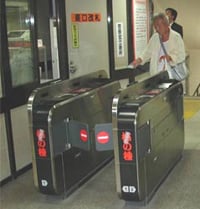 If only there were a way to harness the electricity of the people just walking down the street ...
If only there were a way to harness the electricity of the people just walking down the street ...
Researchers in Japan are working on that one, and they might have hit on the answer. Specifically, it’s scientists at the East Japan Railway Company, and they’re testing the development of a ticket gate that would generate electricity from each person who walks through. That’s potentially thousands or even tens of thousands of people each day, and even a small amount of electricity generated by each of these people would be enough to power the station for perhaps the entire day.
The technology involved is piezoelectricity, the same kind of energy used in quartz clocks and computers, which use frequency multipliers to reach the megahertz range. The scientists actually have a device in place, at the railway company’s head office in Shibuya; and they are testing it for a week or so. The machine embedded in the gate generates a small amount of electricity each time someone walks through. Assuming that tests are successful and the company can justify the installation cost in eventual savings, piezo-powered gates will begin appearing in train stations sometime later this year.
Read More  | Orgismo via TreeHugger
| Orgismo via TreeHugger
Gallery: Japanese Scientists Working on Commuter-generated Electricity
ZScanner 700: Handheld Continuous 3D Hi-def Imager
Posted by Dave White Categories: Accessories, Design, Handhelds, Peripherals, Science,
 Now this is a powerful device. The ZScanner 700 looks heavy-duty, and it certainly is. It will also take a toll on your finances.
Now this is a powerful device. The ZScanner 700 looks heavy-duty, and it certainly is. It will also take a toll on your finances.
The handheld unit can make a three-dimensional polygon mesh of anything in just a few minutes. The ZScanner 700 comes with a set of reflective markers, which you attach to your target. Hook up the scanner to your laptop and sit back and watch. Using lasers and dual cameras, the scanner will zip a scan of the object to your computer. Once you have the image, you can do everything you’d expect to be able to, including rotating, burning and dodging, reducing resolution, and all kinds of other fun tricks. It’s all 3D, and it’s one continuous scan.
Designed primarily for the medical community, ths ZScanner 700 would also fit well in the hands of a heavy-duty graphic designer.
You’ll pay a pretty penny for this one, though. Pricing starts at $39,000 USD.
Read More  | Zcorp via Medgadget
| Zcorp via Medgadget
Gallery: ZScanner 700: Handheld Continuous 3D Hi-def Imager
Advertisement
© Gear Live Inc. {year} – User-posted content, unless source is quoted, is licensed under a Creative Commons Public Domain License. Gear Live graphics, logos, designs, page headers, button icons, videos, articles, blogs, forums, scripts and other service names are the trademarks of Gear Live Inc.


